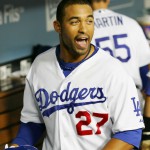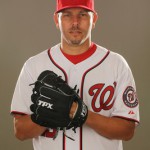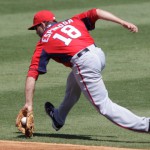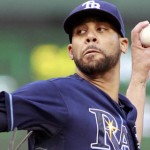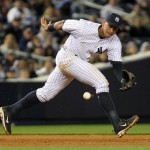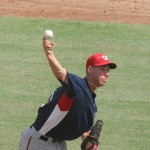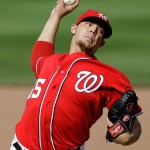Nothing like a time-waster for the weekend; Bill Ladson‘s latest inbox plopped Friday afternoon 1/31/14. Here’s how I’d have responded if someone had bothered to as me these questions 🙂
Q: Even though the Nationals are confident with Denard Span in center field and they have strong center fielders in the Minors, is it possible that they might try to get Matt Kemp at the Trade Deadline or next offseason?
A: Matt Kemp‘s name has come up in this blog in the discussion spaces once before in an interesting “what-if” game. The question as it was posed was this: “Would you, straight up and with no salary relief, trade Matt Kemp right now for Anthony Rendon?” Think about it; Kemp is owed $127.5M over the next six seasons ($21-$21.5M per season). He put up MVP numbers in 2011 (many thought he should have won instead of Ryan Braun, even more so after Braun’s positive PED tests) but has floundered with injury and sub-par performances (relative to his salary) for the past two years. Meanwhile Rendon is getting paid a fraction of what Kemp’s salary is, is younger and has room to grow, but so far has been merely a league average player. Its a good question: do you run the risk of a $20M boat anchor on your roster, taking up 1/7th of your salary cap, or do you roll the dice that Kemp returns to his former glory and earns his pay? Or do you bet on Rendon becoming a significant player cost contained and under team control for another 5 years?
For me, I think you stay away from Kemp. That’s a ton of money with no guarantee that 2014 will be any different from 2013, and the Nats already have enough pending payroll problems without adding one more $20M player.
As for the question at hand, I see no inclination for Mike Rizzo to make such a move, now or ever. He spent a lot of capital (our best starting pitching prospect at the time in Alex Meyer) to get Denard Span, he sought him out and coveted openly him for years, and now he has him. Span’s not going anywhere. As for next year, we’re in a wait and see. One of our best prospects is a CF candidate in Brian Goodwin, but he took a step back in 2013. If Goodwin steps back up in 2014 or doesn’t pan out, we can exercise Span’s 2015 option at $9M and wait for the next best CF prospect in our system (Michael Taylor) to grow. If neither prospect pans out, we don’t have to worry about it for a few years. But, at some point you hope this team can grow another prospect to replace an aging $9M free agent with a minimum salary guy.
Ladson basically says what I say, but in fewer words.
Q: The Nationals still have bullpen questions that were not addressed during the offseason. Do you think the Nats will sign another lefty for the bullpen? Or will they use Ross Detwilerin relief?
A: Do we have bullpen questions? Where? We got a lefty (Jerry Blevins) and we have another decent lefty option who pitched decently for us last year (Xavier Cedeno). I’m quite pleased with the state of our back-end guys (Soriano and Clippard), our 7th and 8th inning options (Storen and Stammen), and our long-man options (Ohlendorf and Roark). Remember; Clippard has great lefty splits, always has. If our loogy doesn’t work out that well, we go back to using Clippard periodically as a match-up guy. Or we call up Sammy Solis. Hell, we could even try Matthew Purke as a bullpen option (he’s on the 40-man after all); scouts are souring on him ever being an effective starter, but his weird motion and shorter stints could help him feature as a bullpen guy. I think you use Ross Detwiler as a starter until he proves otherwise; as mentioned in this space time and again, Detwiler was effective in 2012, started well in 2013 and got hurt; I have no doubt that if healthy he can start 2014 as he started 2013. Ladson says similar things about our lefty options.
Q: How is Adam LaRoche‘s health going into Spring Training? He looked as if he lost a tremendous amount of weight last year.
A: Adam LaRoche looked healthy enough in all those shots that appeared of him killing things on the internet over the winter. Seriously; who knows what the answer to this question is. But we know he’s aware of the situation and should be taking steps to maintain his strength and weight in 2014. It is a contract year after all, and he’s shown a proclivity towards having career years in contract years when he needs them to secure his next paycheck. I can’t see him “platooning” like a lot of bloggers seem to be calling for, but I can see him being told by management that he needs to maintain his production or he may be banished in phantom DL trips. Ladson reports that LaRoche was taking an ADD medication, believes he has it figured out, and predicts a Gold Glove in 2014. Random prediction but sounds good.
Q: Any chance Nationals could bring back Jesus Flores as a backup to Wilson Ramos?
A: Well, Jesus Flores is still out there as a MLFA. What doesn’t speak well of him is the fact that he was released in May of last year by the Dodgers. Clearly to me, he’s no longer a viable major league backup candidate. I can still see the Nats giving a non-guaranteed contract to one of the few remaining veteran catchers to see if one of them sticks as Ramos’ backup, but at this point I wouldn’t be surprised to see the winner of a competition between Jhonatan Solano and Sandy Leon sticking as the backup. That being said, both these guys were awful in 2013 in the minors offensively and I don’t have a good explanation why. Leon seems like the better bet; better history of batting, younger. Chris Snyder has had a rough couple years but is still relatively young and has had stretches of decency, if the team wants to go with a veteran backup instead of a rookie. I dunno what’s going to happen. On the bright side, Keith Law‘s just-released top 10 for the system (ESPN Insider only) includes one Pedro Severino, giving him relatively glowing grades for his defense. He’s a couple years away (born in 1993) but if he succeeds in Potomac this year he could be a ready-made Ramos backup sooner than later. Ladson says the team had a problem with the way Flores called games … hmm, never heard that before. Ladson also predicts more signings before Feb 1.
Q: I sense a double standard: why give continued chances to Danny Espinosa but essentially shut out Drew Storen? Am I missing something? Similar struggles, but at least Drew fought his way back to the Majors.
A: I’m not sure what “chances” Danny Espinosa is getting at this point, nor am I sure what Storen has been “shut out” of. The team bought Rafael Soriano, are paying him a ton of money, and he’s the closer as long as he’s here. That’s that; both Storen and Clippard got pushed down a peg when he got acquired. Meanwhile, I think its clear that Anthony Rendon is the starter, and Espinosa is playing for a backup role. Maybe there were just too many quotes taken out of context from NatsFest. Ladson re-iterates his believe that Espinosa will be traded.
